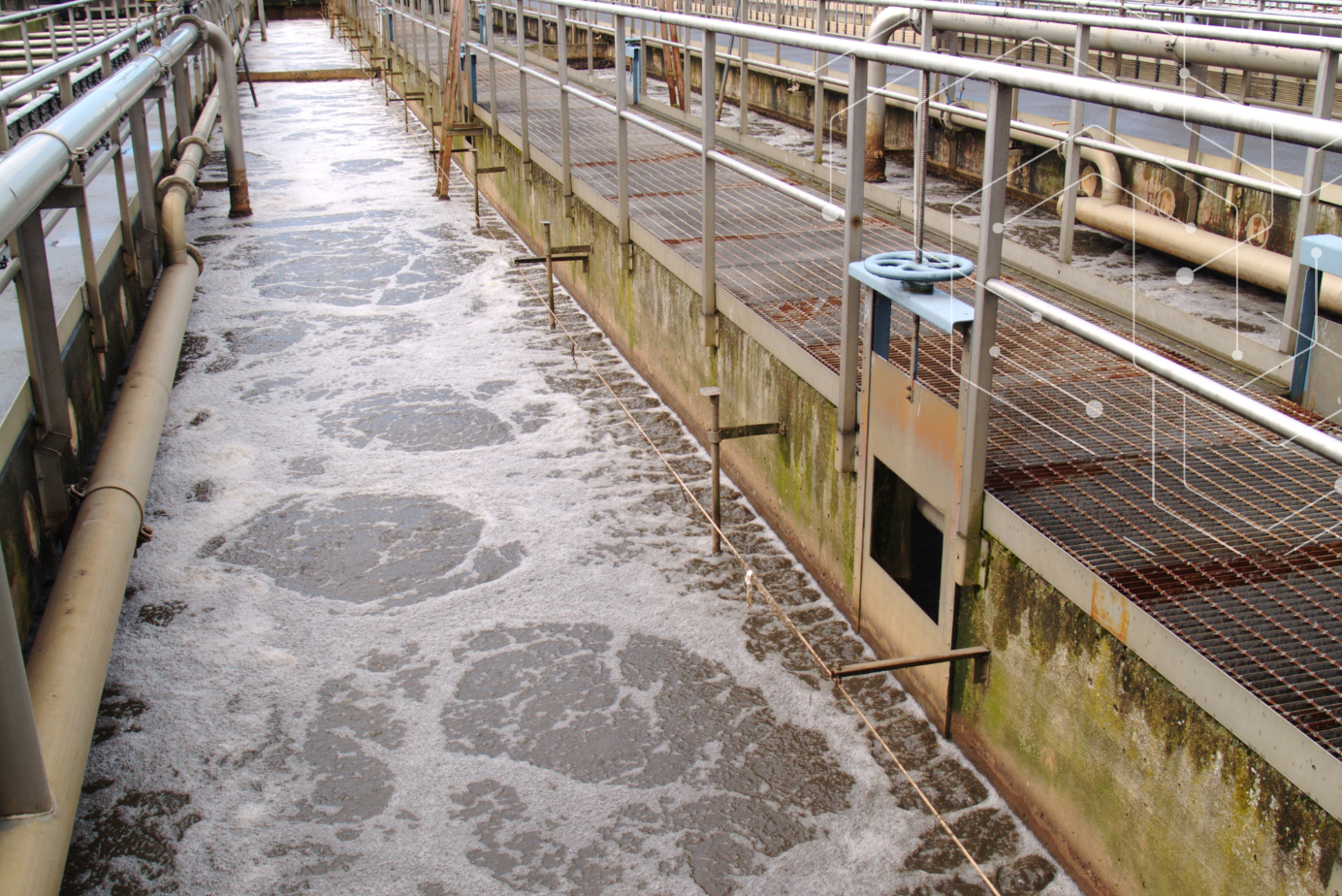The USEPA’s 2021-2024 PFAS Strategic Roadmap calls for a number of actions related to PFAS in biosolids. In this post, we’ll provide our assessment of the challenges PFAS in biosolids present and the best ways to analyze for them.
What are Biosolids and Why Do They Matter?
Often referred to as wastewater sludge, biosolids are a byproduct of wastewater treatment. Traditional wastewater treatment does not remove PFAS. In fact, it can even convert a class of compounds called PFAS precursors into terminal PFAS, such as PFOA and PFOS. Biosolids produced from the treatment of wastewater that contains PFAS are likely to be contaminated.
Before we get into how contaminated biosolids impact the environment and public health, let’s take a quick look at how PFAS enter the wastewater stream in the first place.
Wastewater discharge – Manufacturers that produce PFAS chemicals, use them as a component of finished goods, or use them during production, e.g., as a surfactant, can discharge PFAS in their wastewater effluent. This wastewater may be discharged directly into the environment or sent to a private or municipal wastewater treatment plant for processing.
.png?width=406&height=406&name=landfill%20(3).png) Landfill leachate – As liquid (rain, condensation, liquid waste) passes through a landfill, it can leach PFAS from solid or liquid waste. If the landfill has a leachate collection system, the leachate is often sent to the local wastewater treatment plant for processing.
Landfill leachate – As liquid (rain, condensation, liquid waste) passes through a landfill, it can leach PFAS from solid or liquid waste. If the landfill has a leachate collection system, the leachate is often sent to the local wastewater treatment plant for processing.
Stormwater runoff – Unless properly contained, PFAS that have been handled on site can contaminate the local environment. The aqueous film-forming foam (AFFF) used to fight Class-B chemical fires often contains PFAS as well. After a rain or other release of liquids on the property, PFAS in runoff drains into the sewer system, which is then sent to the local wastewater treatment plant for processing.
Now, let’s look at the ways contaminated biosolids are handled and how that can impact the environment and public health. There are three primary ways wastewater treatment facilities dispose of biosolids produced during wastewater treatment. Unfortunately, none of them are 100% effective at containing the spread of PFAS.
Soil amendments – A couple of years ago, the USEPA estimated that roughly half of the biosolids produced in the U.S. are land-applied as soil amendments. That may be changing as states begin monitoring and regulating the application of biosolids due to increased awareness of PFAS contamination. While Maine is the only state that currently has any sort of ban on land applying biosolids, several other states are considering various legislative approaches to addressing PFAS in biosolids.
When used for agricultural purposes, PFAS can migrate from these biosolids to local soil, ground, and surface waters. They can also contaminate the food supply through plant uptake and the consumption of animals raised on feed grown in contaminated soil. States such as Maine and Michigan have found elevated levels of PFAS in agricultural products such as milk and eggs.
Incineration – Incineration of biosolids is another common method of disposal. However, recent studies have suggested that thermal destruction of PFAS is not as effective as once thought. Soil, ash, groundwater, and air samples taken from incinerator sites and surrounding neighborhoods have shown elevated levels of PFAS.
Landfill – Sending biosolids to a municipal landfill (or using biosolids as landfill) is also problematic. If the biosolids contain PFAS, leachate from the landfill is also likely to contain PFAS. When the leachate is sent to the local wastewater treatment plant, the cycle of contamination begins again.
How are biosolids regulated?
At the federal level, the Clean Water Act (CWA) regulates the use and disposal biosolids, but it does not currently address PFAS contamination in biosolids. While regulatory changes can take time, the USEPA can use existing programs and protocols to begin addressing the challenge.
.png?width=407&height=407&name=lake%20(1).png) One such program is the National Pollutant Discharge Elimination System (NPDES). Created in 1972 under the auspices of the CWA, NPDES is a permitting program designed to regulate the discharge of pollutants into the waters of the U.S. (WOTUS). States can petition the USEPA to administer their own NPDES program, and the majority of states have received partial or full approval. In a 2022 memo, the USEPA issued NPDES permitting guidance to the states. In addition to addressing wastewater discharge, the agency recommended the regular monitoring of biosolids for PFAS.
One such program is the National Pollutant Discharge Elimination System (NPDES). Created in 1972 under the auspices of the CWA, NPDES is a permitting program designed to regulate the discharge of pollutants into the waters of the U.S. (WOTUS). States can petition the USEPA to administer their own NPDES program, and the majority of states have received partial or full approval. In a 2022 memo, the USEPA issued NPDES permitting guidance to the states. In addition to addressing wastewater discharge, the agency recommended the regular monitoring of biosolids for PFAS.
At the state level, awareness is growing, albeit slowly. The Environmental Council of the States (ECOS) conducted a survey of states asking about their approach to PFAS in biosolids. Thirty-four states responded to the survey, including several states that don’t normally crop up in PFAS discussions, e.g., North Dakota, Kansas, Wyoming, etc. Agriculturally rich, officials in these states may soon have to deal with the PFAS problem, perhaps for the first time.
The majority of the states that responded either don’t have current or proposed legislation related to PFAS in biosolids (27 of 34) or aren’t even considering it (23 of 34). However, the fact they responded to the survey could be taken as a sign that they are at least aware of it.
Test Methods for Analyzing Biosolids for PFAS Levels
Analyzing for PFAS in biosolids requires a different method than analyzing for PFAS in other matrices, such as drinking water. Historically, many labs have used the core technical elements for the EPA-published drinking water method – EPA Method 537 – in a lab-specific SOP commonly called 537M or 537 Modified. The use of the label Method 537M has caused some confusion in the industry, as there is no codified standardization between modified methods. Furthermore, Method 537 is not designed for biosolids.
At Pace®, we developed a method called PFAS by Isotope Dilution that incorporates the Department of Defense (DOD) Quality System Manual (QSM), Table B-15. QSM Table B-15 isn’t a method, per se, but a table of quality control protocols for the testing of PFAS in non-potable water, solids, AFFF (aqueous film-forming foam), and biota.
The challenge of using lab-specific SOPs such as 537M and PFAS by Isotope Dilution for any matrix such as biosolids will soon be resolved once the USEPA finalizes Draft Method 1633. The draft and final version of the method provides quantification of 40 compounds across a wide range of solid and aqueous matrices, including biosolids. Pace® is participating in the multi-lab validation of Draft Method 1633, and we recently conducted a webinar highlighting changes made to the 3rd Draft of Draft Method 1633.
Watch: A Deep Dive into the Third Draft of Method 1633 for PFAS.
In the webinar, Stephen Somerville, Pace® PFAS Technical Director, did an excellent job highlighting some of the current limitations of the 3rd Draft, areas where modifications/clarifications may be made before finalization, and how EPA Method 1633 compares to other legacy methods. We’ll be publishing the Q&A from that webinar in this blog shortly. Subscribe to our blog to make sure you get the FAQ in your inbox.
How Pace® Can Help
Pace® will continue to offer PFAS by Isotope Dilution for some projects, including those involving PFAS in biosolids. However, we are already offering EPA Method 1633 in several of our PFAS labs, and once finalized, we anticipate EPA Method 1633 will become the primary method for analyzing PFAS in non-potable water, solids, and other matrices. If you’re not sure which method is best for your project, reach out to us. We’d be happy to answer any questions you have and help provide some direction.





.png)